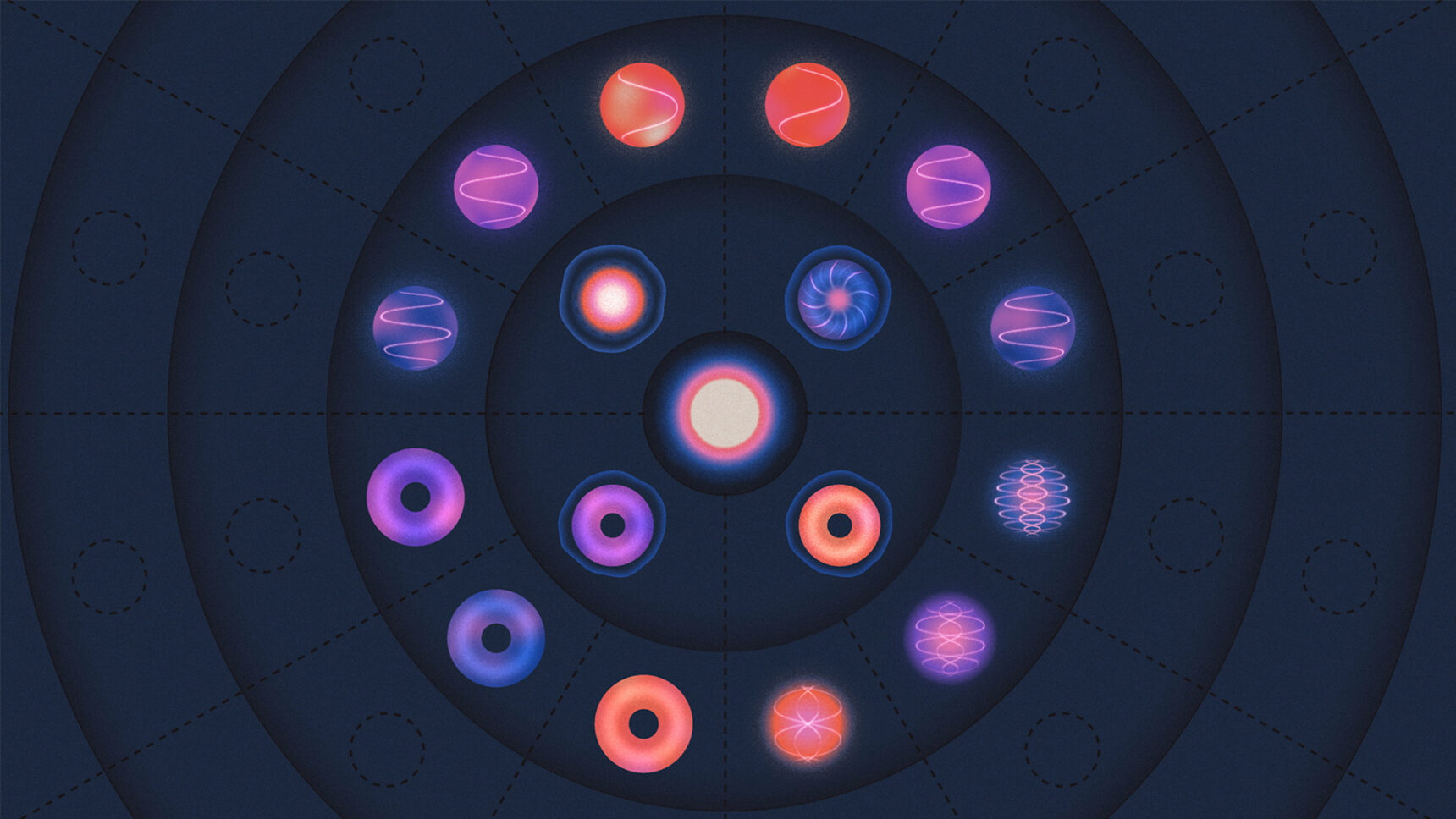Newly Measured Particle Seems Heavy Enough to Break Known Physics
![Illustration in which the particles of the Standard Model are arranged as sections of a circle, but the W boson is too big and doesn’t fit.]](https://www.quantamagazine.org/wp-content/uploads/2022/04/W-Boson_2880x1620_Lede.jpg)
The curious heaviness of the W boson, one of 17 known elementary particles, may point to unknown particles or forces.
Samuel Velasco/Quanta Magazine
Introduction
Physicists have found that an elementary particle called the W boson appears to be 0.1% too heavy — a tiny discrepancy that could foreshadow a huge shift in fundamental physics.
The measurement, reported today in the journal Science, comes from a vintage particle collider at the Fermi National Accelerator Laboratory in Batavia, Illinois, that smashed its final protons a decade ago. The roughly 400 members of the Collider Detector at Fermilab (CDF) collaboration have continued to analyze W bosons produced by the collider, called the Tevatron, chasing down myriad sources of error to reach an unparalleled level of precision.
If the W’s excess heft relative to the standard theoretical prediction can be independently confirmed, the finding would imply the existence of undiscovered particles or forces and would bring about the first major rewriting of the laws of quantum physics in half a century.
“This would be a complete change in how we see the world,” potentially even rivaling the 2012 discovery of the Higgs boson in significance, said Sven Heinemeyer, a physicist at the Institute for Theoretical Physics in Madrid who is not part of CDF. “The Higgs fit well into the previously known picture. This one would be a completely new area to be entered.”
The finding comes at a time when the physics community hungers for flaws in the Standard Model of particle physics, the long-reigning set of equations capturing all known particles and forces. The Standard Model is known to be incomplete, leaving various grand mysteries unsolved, such as the nature of dark matter. The CDF collaboration’s strong track record makes their new result a credible threat to the Standard Model.
“They’ve produced hundreds of beautiful measurements,” said Aida El-Khadra, a theoretical physicist at the University of Illinois, Urbana-Champaign. “They’re known to be careful.”
But no one is popping champagne yet. While the new W mass measurement, taken alone, departs starkly from the Standard Model’s prediction, other experiments weighing the W have produced less dramatic (albeit less precise) results. In 2017, for instance, the ATLAS experiment at Europe’s Large Hadron Collider measured the W particle’s mass and found it to be only a hair heavier than what the Standard Model says. The clash between CDF and ATLAS suggests that one or both groups has overlooked some subtle quirk of their experiments.
“I would like it to be confirmed and to understand the difference from prior measurements,” said Guillaume Unal, a physicist at CERN, the laboratory that houses the Large Hadron Collider, and a member of the ATLAS experiment. “The W boson has to be the same on both sides of the Atlantic.”
“It’s a monumental piece of work,” said Frank Wilczek, a Nobel Prize-winning physicist at the Massachusetts Institute of Technology, “but it’s very hard to know what to do with it.”
Weak Bosons
W bosons, together with Z bosons, mediate the weak force, one of the universe’s four fundamental forces. Unlike gravity, electromagnetism and the strong force, the weak force doesn’t push or pull so much as it transforms heavier particles into lighter ones. A muon spontaneously decays into a W boson and a neutrino, for instance, and the W then becomes an electron and another neutrino. Related subatomic shape-shifting causes radioactivity and helps keep the sun shining.
Assorted experiments have measured the W and Z bosons’ masses over the last 40 years. The W boson’s mass has proved an especially alluring target. Whereas other particle masses must simply be measured and accepted as facts of nature, the W mass can be predicted by combining a handful of other measurable quantum properties in the Standard Model equations.
For decades, experimentalists at Fermilab and elsewhere have exploited the web of connections surrounding the W boson to try to detect additional particles. Once researchers had accurate measurements of the terms that most heavily influence the W particle’s mass — numbers like the strength of the electromagnetic force and the mass of the Z — they could start to sense the smaller effects tugging at its mass.
This approach let physicists predict the mass of a particle called the top quark, which nudges the mass of the W, in the 1990s, just ahead of the top quark’s discovery in 1995. And they repeated the feat in the 2000s to anticipate the mass of the Higgs boson before its detection.
But while theorists had various reasons to expect the top quark and the Higgs to exist, and to be connected to the W boson through the equations of the Standard Model, today the theory has no obviously missing pieces. Any remaining discrepancy in the W boson’s mass would point toward the unknown.
Catching W’s
CDF’s new mass measurement is based on an analysis of about 4 million W bosons produced at the Tevatron between 2002 and 2011. When the Tevatron crashed protons into antiprotons, a W boson often popped up in the ensuing commotion. The W could then decay into a neutrino and either a muon or an electron, both straightforward to detect. The faster the muon or electron, the heavier the W boson that produced it.
Ashutosh Kotwal, a physicist at Duke University and the driving force behind the CDF collaboration’s recent analysis, has devoted his career to refining that scheme. The heart of the W boson experiment is a cylindrical chamber packed with 30,000 high-voltage wires that react when a muon or electron flies through them, allowing the CDF researchers to infer the particle’s path and speed. Knowing the exact position of each wire is crucial to getting an accurate trajectory. For the new analysis, Kotwal and his colleagues took advantage of muons that rain down from the sky as cosmic rays. These bulletlike particles constantly rip through the detector in almost perfectly straight lines, letting the researchers detect any wonky wires and pin down the wires’ positions to within 1 micrometer.
They also spent the years between data releases doing exhaustive cross-checks, repeating measurements in independent ways to build confidence that they understood Tevatron’s every idiosyncrasy. All the while, W boson measurements piled up faster and faster. CDF’s last analysis, released in 2012, covered data from the Tevatron’s first five years. Over the next four years, the data quadrupled.
![Photo of a large cylindrical contraption. Two people in hard hats stand on a scissor lift in front of the detector.]](https://www.quantamagazine.org/wp-content/uploads/2022/04/CDFdetector01-0060-06-hr.jpg)
The CDF detector, one of two experiments positioned at different points around the 4-mile ring of the Tevatron particle accelerator, shown here during its installation in 2001.
Fermilab
“It came at us like a fire hose, faster than you could drink from,” Kotwal said.
Nearly a decade after that last analysis, the collaboration has finally come up for air. In a November 2020 meeting over Zoom, Kotwal decrypted the team’s result (they had worked with encrypted data so that the numbers wouldn’t influence their analysis) with the press of a button.
Silence fell as the physicists absorbed the answer. They had found that the W boson weighs 80,433 million electron volts (MeV), give or take 9 MeV. That makes it a whopping 76 MeV heavier than the Standard Model predicts, a discrepancy roughly seven times larger than the margin of error of the measurement or prediction.
Such a “seven-sigma” discrepancy rises above the five-sigma level that physicists normally must clear to claim a definitive discovery. But in this case, lower measurements from ATLAS and other experiments gives them pause.
“I would say this is not a discovery, but a provocation,” said Chris Quigg, a theoretical physicist at Fermilab who was not involved in the research. “This now gives a reason to come to terms with this outlier.”
Clash of Experiments
With the Tevatron gathering dust, the onus of confirming or disproving the CDF measurement will fall to the Large Hadron Collider. It has already produced more W bosons than the Tevatron did, but its higher collision rate complicates the analysis of the W’s mass. Nevertheless, by collecting additional data — potentially at lower beam intensities — the LHC can resolve the tension in the coming years.
Meanwhile, theorists can’t help but ponder what an oversize W boson might mean.
When a muon briefly emits a W boson as it decays into an electron, that intermediate W boson can interact with other particles, even undiscovered ones. It’s this fraternization with the unknown that could skew the W’s mass.
A heavy W boson could potentially be due to a second Higgs boson that’s more standoffish than the one we know. Or it could be due to a new massive boson that mediates a variant of the weak force, or a “composite” Higgs made of multiple particles, complete with a new force to bind them together.
Some theorists suspect particles predicted by a long-studied theory known as supersymmetry. This framework links matter particles and force-carrying particles, positing an undiscovered partner of the opposite type for each of the known particles. Supersymmetry fell out of vogue after “superpartners” failed to materialize at the LHC, but some theorists still believe it to be true.
Heinemeyer and collaborators recently calculated that certain supersymmetric particles could resolve another putative discrepancy with the Standard Model known as the muon g-2 anomaly. In so doing, the particles would also nudge the W boson’s mass up a bit, although even more newcomers would be needed to match the CDF measurement. “It’s fascinating that particles that help us with g-2 might also help us with the W boson mass,” he said.
The painstaking work of experimentalists in honing their precision measurements makes researchers more optimistic that a long-awaited breakthrough is coming.
“It overall just feels to me like we’re getting close to the point where something’s going to break,” said El-Khadra. “We’re getting close to really seeing beyond the Standard Model.”




